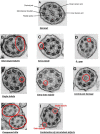Functional analysis and evaluation of respiratory cilia in healthy Chinese children
- PMID: 33036612
- PMCID: PMC7545929
- DOI: 10.1186/s12931-020-01506-w
Functional analysis and evaluation of respiratory cilia in healthy Chinese children
Abstract
Background: To aid in the diagnosis of Primary Ciliary Dyskinesia (PCD) and to evaluate the respiratory epithelium in respiratory disease, normal age-related reference ranges are needed for ciliary beat frequency (CBF), beat pattern and ultrastructure. Our aim was to establish reference ranges for healthy Chinese children.
Methods: Ciliated epithelial samples were obtained from 135 healthy Chinese children aged below 18 years by brushing the inferior nasal turbinate. CBF and beat pattern were analysed from high speed video recordings. Epithelial integrity and ciliary ultrastructure were assessed using transmission electronic microscopy.
Results: The mean CBF from 135 children studied was 10.1 Hz (95% CI 9.8 to 10.4). Approximately 20% (ranged 18.0-24.2%) of ciliated epithelial edges were found to have areas of dyskinetically beating cilia. Normal beat pattern was observed in ciliated epithelium from all subjects. We did not find any effect of exposure to second hand smoke on CBF in our subjects. Microtubular defects were found in 9.3% of all of the cilia counted in these children, while other ciliary ultrastructural defects were found in less than 3%.
Conclusions: We established the reference range for CBF, beat pattern and ultrastructure in healthy Chinese children. Using similar methodology, we found a lower overall mean CBF than previously obtained European values. This study highlights the need to establish normative data for ciliary function in different populations.
Keywords: Beat frequency; Beat pattern; Chinese children; Nasal cilia; Reference data; Ultrastructure.
Conflict of interest statement
The authors declare that they have no competing interests.
Figures




Similar articles
-
Functional analysis of cilia and ciliated epithelial ultrastructure in healthy children and young adults.Thorax. 2003 Apr;58(4):333-8. doi: 10.1136/thorax.58.4.333. Thorax. 2003. PMID: 12668798 Free PMC article.
-
Variation of Ciliary Beat Pattern in Three Different Beating Planes in Healthy Subjects.Chest. 2017 May;151(5):993-1001. doi: 10.1016/j.chest.2016.09.015. Epub 2016 Sep 29. Chest. 2017. PMID: 27693596
-
Diagnostic testing of patients suspected of primary ciliary dyskinesia.Am J Respir Crit Care Med. 2010 Feb 15;181(4):307-14. doi: 10.1164/rccm.200903-0459OC. Epub 2009 Nov 12. Am J Respir Crit Care Med. 2010. PMID: 19910612
-
Intracellular Cl- Regulation of Ciliary Beating in Ciliated Human Nasal Epithelial Cells: Frequency and Distance of Ciliary Beating Observed by High-Speed Video Microscopy.Int J Mol Sci. 2020 Jun 5;21(11):4052. doi: 10.3390/ijms21114052. Int J Mol Sci. 2020. PMID: 32517062 Free PMC article. Review.
-
The challenges of diagnosing primary ciliary dyskinesia.Proc Am Thorac Soc. 2011 Sep;8(5):434-7. doi: 10.1513/pats.201103-028SD. Proc Am Thorac Soc. 2011. PMID: 21926395 Free PMC article. Review.
Cited by
-
Ultrastructure for the diagnosis of primary ciliary dyskinesia in South Africa, a resource-limited setting.Front Pediatr. 2023 Aug 14;11:1247638. doi: 10.3389/fped.2023.1247638. eCollection 2023. Front Pediatr. 2023. PMID: 37645034 Free PMC article.
-
Cilia Ultrastructure Associated with Primary Ciliary Dyskinesia in Omani Patients.Sultan Qaboos Univ Med J. 2023 Feb;23(1):76-80. doi: 10.18295/squmj.4.2022.029. Epub 2023 Feb 23. Sultan Qaboos Univ Med J. 2023. PMID: 36865419 Free PMC article.
-
Key gene network related to primary ciliary dyskinesia in hippocampus of patients with Alzheimer's disease revealed by weighted gene co-expression network analysis.BMC Neurol. 2022 May 30;22(1):198. doi: 10.1186/s12883-022-02724-z. BMC Neurol. 2022. PMID: 35637434 Free PMC article.
-
Functional Evaluation and Genetic Landscape of Children and Young Adults Referred for Assessment of Bronchiectasis.Front Genet. 2022 Aug 8;13:933381. doi: 10.3389/fgene.2022.933381. eCollection 2022. Front Genet. 2022. PMID: 36003331 Free PMC article.
-
Bronchial epithelia from adults and children: SARS-CoV-2 spread via syncytia formation and type III interferon infectivity restriction.Proc Natl Acad Sci U S A. 2022 Jul 12;119(28):e2202370119. doi: 10.1073/pnas.2202370119. Epub 2022 Jun 24. Proc Natl Acad Sci U S A. 2022. PMID: 35749382 Free PMC article.
References
MeSH terms
Grants and funding
LinkOut - more resources
Full Text Sources

